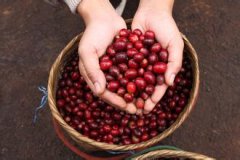Kenyan coffee history? What are the relevant coffee institutions in Kenya?

Professional coffee knowledge exchange more coffee bean information please follow the coffee workshop (Wechat official account cafe_style)
Kenyan coffee, known as the "Cup of connoisseurs" (Connoisseurs' Cup), is famous in the coffee industry for its rich aroma, bright and vibrant acidity, full and elegant mellowness and red wine flavor. Caffeine in different producing areas has its own subtle flavor due to the difference of microclimate.
History of coffee in Kenya
Although it is adjacent to Ethiopia, the birthplace of coffee, coffee cultivation does not have a long history. It is generally believed that coffee was brought to Kenya in the late 19th century by the priests of the Holy Spirit Church (Fathers of Holy Spirit congregation). It is more common to say that it came from the island of Reunion (Bourbon, where coffee was found in Bourbon) in 1893, or from Ethiopia.
When coffee first arrived, Kenya was under British rule, and coffee cultivation was promoted to earn foreign exchange. In 1963, when Kenya became independent, the status of coffee did not decline, but was consolidated and was an important component of Kenya's trade income.
Coffee growing area in Kenya
The coffee producing areas in Kenya are mainly concentrated in Mount Kenya (Mt. The plateau region represented by Kenya). Tropical climate, acid red volcanic soil provides a natural and suitable growth environment for coffee. The main producing areas are Nyeri and Ruiru in the middle of the country.
Kenyan Coffee: Overview
Kenyan coffee varieties
Bourbon Bourbon was first brought to Kenya for planting. In the 1950s, the then agricultural research institution Scott Laboratory selected two excellent hybrids, SL-28 and SL-34, through unremitting efforts, subverting the long-standing prejudice of artificial breeding without excellent natural varieties. SL-28 and SL-34 help Kenyan coffee to form its own unique flavor characteristics and establish a perfect reputation in the coffee industry.
Like the choice of other coffee producing countries, although SL-28 and SL-34 have stood the test of time and cultivated generation after generation of faithful pumps for Kenyan coffee, the Kenyan government and the Coffee Research Institute (Coffee Research Foundation) have begun to promote a new variety, Ruiri 11, for the sake of coffee yield and disease resistance. The promoters assure coffee lovers that the new variety still has the classic flavor of Kenyan coffee. However, the continuous efforts have not won the recognition of coffee gluttons, who agree that the new varieties lack taste and that the future of Ruiru11 remains to be seen.
In addition to the prestigious traditional Arabica coffee, robusta coffee is also produced in the western lowlands of Kenya.
Coffee cultivation in Kenya
Mainly by large farms (Estate) and cooperatives (Cooperatives) two types. The former generally has a large planting area and has independent coffee processing facilities. Most coffee production is done by a large number of small farmers, who form coffee cooperatives. The Coffee Cooperative Society employs special managers to supervise the coffee processing of its members, even to the point of managing each coffee tree.
Compared with shading planting in many high-quality producing areas, Kenyan coffee is obviously more spicy and unrestrained, and shade trees are not common. In addition, Kenyan coffee rarely participates in certification, variety and environmental factors make the use of pesticides necessary, and organic certification, which is popular in other countries, becomes rare in Kenya.
Kenyan coffee harvest season
There are two harvest seasons in Kenya, the main harvest season is from October to December and the secondary harvest season is from May to July.
Kenyan coffee processing
Large farms usually have independent treatment facilities. A large number of small farmers usually pick ripe coffee fruits by hand. Coffee picking is a labor-intensive job that requires the whole family to deploy and even hire workers during the harvest season. The fresh fruit of the picked coffee needs to be delivered in time to the cooperative-owned coffee processing plant for pulping, which may be carried by ox carts, pick-up trucks or trucks. After peeling, Parchment coffee is briefly kept in the cooperative's processing plant and sent to a privately owned factory for shelling treatment.
Kenyan Coffee: Overview
Coffee auction and Direct Trade in Kenya
Almost all Kenyan coffee is sold through the coffee exchange in Nairobi, the capital. Coffee auctions are held at coffee exchanges every Tuesday during the harvest season. Traders with trading qualifications will get raw bean samples in advance, and after the cup test, they will choose the raw beans they like. In the following auction, the highest bidder will get. Kenya's coffee auction system is regarded as the model of the popular COE tournament, and it is regarded as the most transparent and efficient way of trade, which can effectively encourage growers to pursue quality and achieve high quality and high price results.
Although the coffee auction system has effectively improved the price of high-quality coffee, it is not without drawbacks. First, the existence of many trade middlemen has eroded the interests of coffee farmers, and the high prices obtained from the auction can not be fully fed back to the hard-working coffee farmers. Second, it is difficult to accurately trace the production information of auctioned coffee. For the booming boutique coffee market, traceability is an important criterion for the evaluation of raw coffee beans. Based on the above factors, the Kenyan government has begun to relax restrictions on direct trade in coffee. State-certified agents can sell coffee beans directly to customers such as foreign boutique coffee roasters. Direct trade can give farmers more rewards for producing high-quality coffee.
Kenyan Coffee: Overview
Kenyan coffee grade
Kenya is a well-known producer based on the size of coffee beans. Usually divided into nine grades, according to the bean type, there are PB, that is, round beans, accounting for about 10% of the total output, in addition to E (elephant beans), AA, AB, C, T, TT, MH, ML according to size.
Coffee related institutions in Kenya
KCPTA: Kenya Federation of Coffee producers and traders, Kenya Coffee Producers and Traders Association
CRF: Kenya Coffee Research Institute, Coffee Research Foundation
KCB: Kenya Coffee Exchange, Kenya Coffee Board
KCTA: Kenyan Federation of Coffee traders, Kenya Coffee Traders Association
Important Notice :
前街咖啡 FrontStreet Coffee has moved to new addredd:
FrontStreet Coffee Address: 315,Donghua East Road,GuangZhou
Tel:020 38364473
- Prev

Characteristics of Brazilian coffee, introduction of Brazilian coffee yellow bourbon varieties.
Professional coffee knowledge exchange more coffee bean information please follow the coffee workshop (Wechat official account cafe_style) of all coffee producing countries, Brazil has the most advantaged geomorphology and weather conditions, gentle plateau topography, dry and wet seasons, so that the local production is several times higher than that of other countries, in terms of Arabian raw bean production, the average per hectare can reach 1.
- Next

Honduras Ajul-Meiamba small Farmer Honey treats Honduran Coffee beans good?
Honduras Ajul-Meiamba small Farmer Honey treats Honduran Coffee beans good? Flavor description: dried fruit aroma, soft sweet and sour flavor, apple, sweet melon, sweet flavor, moist and smooth country of production: Honduras: Comayagua province, near Lake Yojoa producer: Ajul-Azul Meambar coffee small
Related
- Detailed explanation of Jadeite planting Land in Panamanian Jadeite Manor introduction to the grading system of Jadeite competitive bidding, Red bid, Green bid and Rose Summer
- Story of Coffee planting in Brenka region of Costa Rica Stonehenge Manor anaerobic heavy honey treatment of flavor mouth
- What's on the barrel of Blue Mountain Coffee beans?
- Can American coffee also pull flowers? How to use hot American style to pull out a good-looking pattern?
- Can you make a cold extract with coffee beans? What is the right proportion for cold-extracted coffee formula?
- Indonesian PWN Gold Mandrine Coffee Origin Features Flavor How to Chong? Mandolin coffee is American.
- A brief introduction to the flavor characteristics of Brazilian yellow bourbon coffee beans
- What is the effect of different water quality on the flavor of cold-extracted coffee? What kind of water is best for brewing coffee?
- Why do you think of Rose Summer whenever you mention Panamanian coffee?
- Introduction to the characteristics of authentic blue mountain coffee bean producing areas? What is the CIB Coffee Authority in Jamaica?

